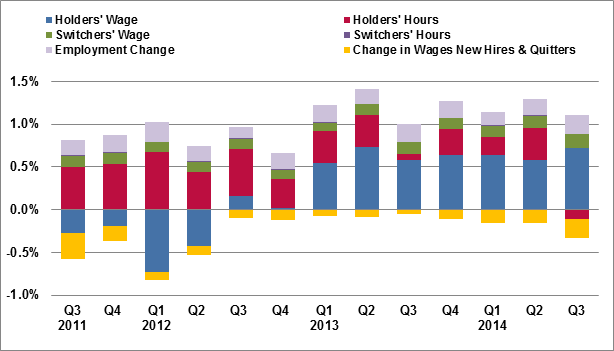Income Tax
Report Shows Real Wages Increased in Third Quarter
The latest ADP Workforce Vitality Index, which measures the total real wages paid to the U.S private sector, is 110.6 in the third quarter of 2014. The index, part of the ADP Workforce Vitality Report, is composed of a number of metrics including ...
Oct. 08, 2014

Wages are increasing in the private sector workforce, according to a new report that takes several factors into account.
The latest ADP Workforce Vitality Index, which measures the total real wages paid to the U.S private sector, is 110.6 in the third quarter of 2014. The index, part of the ADP Workforce Vitality Report, is composed of a number of metrics including job holders’ wages, job holders’ hours worked, job switchers’ wages, and total employment. The index grew by 0.77% from the previous quarter.
The index considers four types of workers in the labor market: those who stay with the same firm (job holders), those who change jobs (job switchers), those who are newly hired by a firm (entrants), and those who left the firm either voluntarily or involuntarily (leavers). There are several factors contributing to the growth of the index. Chart 1 shows the contributions from each of these factors. Real hourly wages, hours worked for job holders and net employment have been the main contributors for the growth of the Index. Since the beginning of 2013, job holders’ wages have become the primary contributor to growth. This may mean that employers are becoming more confident about the economy and are focusing on retaining their talent by raising wages. Also shown in Chart 1, the contribution from employment gains has remained steady.
“The growth we are showing in the ADP Workforce Vitality Index is being primarily driven by an increase in real hourly wage rates,” said Ahu Yildirmaz, vice president and head of the ADP Research Institute. “This is a good sign that may lead to increased consumer spending and a boost for the economy.”
The ADP Workforce Vitality Index grew faster in the South and West compared to the Northeast and Midwest Regions. Real hourly wage growth and employment growth has driven the growth in the South and West. Real hourly wages grew most quickly in trade industries, which include retail trade. Professional Services, which include technology companies, drove employment growth in the South. While the ADP Workforce Vitality Index has trended higher in all four regions over the past three years, the gap between South & West and Midwest & Northeast began to appear in the second half of 2012 and has been growing ever since. This widening gap can be attributed to faster employment growth, a slower decline in the growth rate of hours-worked and faster growth of real hourly wages in the South and West.
The ADP Workforce Vitality Report was developed by the ADP Research Institute in collaboration with Moody’s Analytics. It is an unprecedented, in-depth quarterly analysis of the overall vitality of the U.S. labor market based on actual data that identifies labor market trends and dynamics across multiple dimensions. These dimensions include employment growth, job turnover, wage growth and hours worked. In addition to the macro data presented in the report, there are also segment-specific findings by industry, state, gender, age, experience, and pay level. More information about the report is available via ADP.
